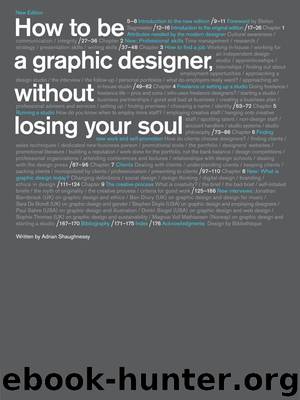How to be a graphic designer, without losing your soul by Adrian Shaughnessy

Author:Adrian Shaughnessy
Language: eng
Format: epub
Publisher: Princeton Architectural Press and Laurence King Publishing Ltd
Published: 2010-03-25T16:00:00+00:00
/ Chapter 7
Clients Dealing with clients / understanding clients / keeping clients / sacking clients / monopolized by clients / professionalism / presenting to clients. Why there is no such thing as a bad client, only bad client handling. Or why we always blame our clients for our own failings.
There are no bad clients, only clients turned into bad clients by bad designers. This is a slight exaggeration, perhaps, but only slight. Clients are a bit like dogs: if we feed dogs and look after their basic needs they reward us with loyalty and devotion; but if we beat them and starve them, they become snarling mutts who’d sooner bite your hand than lick it. Same goes for clients: if we want ethical clients we have to be ethical designers; if we want visionary clients we have to be visionary designers; if we want “good” clients we have to be “ultra-good” designers.
In earlier chapters we’ve looked at what makes a good designer—but what makes a good client? Well, good clients are rarely compliant; they are usually demanding, inquisitive, infuriating, and maddeningly inconsistent—but with a fundamental sense of fairness. One thing’s for sure: clients don’t need to “know about design” to be good clients. Some of the best clients I’ve ever worked with had no previous experience of commissioning design. This contradicts the arrogant, often-heard designer dictum that states “we must educate our clients about design.” This is wrong—we must educate ourselves about our clients.
The poor old client is often masked out of design history and design journalism, not to mention critical and theoretical discourse. If clients are mentioned, it is usually as an amorphous, barely tolerated, and reactionary force, and it is rare for them to be publicly congratulated for their sponsorship, patronage, or encouragement of good design. This chapter speaks up for the clients. Even the ones that bite.
Dealing with clients
The writer Robin Kinross, writing about Dutch designer Karel Martens in Eye, turned his nose up at the word “client.” He wrote: “opdrachtgevers [commission giver], the Dutch word is better than our sleazy ‘client’.” You know what Kinross means—there is something sleazy and out of date about the notion of the all-powerful client. But we must resist demonizing our “commission givers;” it’s counterproductive. I suggest we try to think of clients as partners: the traditional notion of the client as an all-powerful bestower of commissions is as off-target as the idea of the designer as a humble recipient of the crumbs from the rich man’s table. This old model no longer works.
So how should we deal with clients? Should we treat them like we treat our friends and the people we meet in our social lives, or should we veer toward the more formal protocols of business etiquette? Well, no two clients are the same. They all need something different: this one needs deference; this one is obsessed with value for money; this one is suspicious of designers and unconvinced by arguments about the value of good design; this
Download
This site does not store any files on its server. We only index and link to content provided by other sites. Please contact the content providers to delete copyright contents if any and email us, we'll remove relevant links or contents immediately.
Wonder by R.J. Palacio(7723)
Unlabel: Selling You Without Selling Out by Marc Ecko(2975)
POP by Steven Heller(2878)
Hidden Persuasion: 33 psychological influence techniques in advertising by Marc Andrews & Matthijs van Leeuwen & Rick van Baaren(2771)
The Pixar Touch by David A. Price(2736)
Ogilvy on Advertising by David Ogilvy(2677)
Drawing Cutting Edge Anatomy by Christopher Hart(2671)
Slugfest by Reed Tucker(2411)
The Art of War Visualized by Jessica Hagy(2408)
The Curated Closet by Anuschka Rees(2378)
Stacked Decks by The Rotenberg Collection(2266)
The Wardrobe Wakeup by Lois Joy Johnson(2228)
365 Days of Wonder by R.J. Palacio(2227)
The Code Book by Simon Singh(2202)
Rapid Viz: A New Method for the Rapid Visualization of Ideas by Kurt Hanks & Larry Belliston(2189)
Tell Me More by Kelly Corrigan(2189)
Keep Going by Austin Kleon(2154)
Tattoo Art by Doralba Picerno(2079)
Tokyo Geek's Guide: Manga, Anime, Gaming, Cosplay, Toys, Idols & More - The Ultimate Guide to Japan's Otaku Culture by Simone Gianni(1941)
